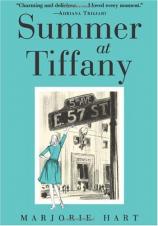Summer at Tiffany
Review
Summer at Tiffany
Coming to Manhattan with little money and one secondhand
reference takes great bravery and pluck, particularly in war-torn
America in 1945. Images from movies and the grand sweeping melodies
of standard tunes of the era provide Marjorie Hart and her best
friend Marty with a jumping-off point as tourists. But as they make
do with what little they've brought with them, they end up becoming
bonafide New Yorkers for a summer that ends triumphantly with love
all around and a VJ Day celebration in Times Square.
The details of the time, the mores and concerns of a young lady in
this pre-women's-lib period, are wrought quite skillfully and
imaginatively by Hart, a first-time memoirist. A cellist by trade,
she never lets go of either her Iowa good sense or her little
girl's love of all things romantic and exciting. So she becomes a
first-rate tour guide through a New York that remains only between
Trump-sized towers and well-known chain stores. The drama --- for
example, of saving enough CHANGE to take public transportation each
day (a nickel!) or trying to figure out what kind of drink to order
in an elegant cafe you've read about in movie magazines your whole
life --- is small but never really quaint. There is enough in
Hart's experiences for even the most jaded techno-kid of this age
to find some commonalities between that world and today's.
But it is the girls' experiences in Tiffany & Co. that make the
book what it is. After Marty brazenly drags Marjorie into the store
and, using a reference that may or may not come through, more or
less demands jobs for them --- making them the first female pages
in the history of Tiffany --- their lives take a dramatic and
fantastic upswing. Living amongst the rich and famous, if only from
9 to 5, gives the girls a lot to talk about and introduces them
both to the sweet side of serious money and the not-so-nice side
(gangsters buying jewels with ill-begotten booty gives them the
creeps yet proves exciting at the same time).
The other denizens of the floors --- including the secret third
floor of Pearls and Diamonds(!), lifers who act like butlers out of
an Evelyn Waugh book, and an elevator man direct from a Damon
Runyan play --- are wonderfully represented. They provide a safe
and secure environment for the girls to learn the ropes of this
high-price business, as well as pointers on life that they take to
heart. In these passages, Hart's direct prose sparkles like the
glow of the famous Tiffany diamond.
The war creates an interesting context for all this movie-magazine
madness. The girls meet enlisted men at Barnard dances and must
endure the painful news from home when someone they know goes MIA
or comes home in a body bag from the war. When a warplane
accidentally hits the Empire State Building, Hart writes about the
experience of the city in its aftermath so intensely that it almost
could be mistaken for a description of 9/11. New York and World War
II, atomic bombs and young love all meld together to offset the
high-society hijinks of Tiffany, giving SUMMER AT TIFFANY a weight
that grounds it in reality while still allowing us the enjoyment of
living vicariously through those for whom it is not as daily a
concern.
Hart never came back to New York after that summer. Although
offered an opportunity to stay on the East Coast and study cello at
Yale, she returned to Iowa and became a music educator as well as a
musician out west. But her experiences in Manhattan that long-ago
summer made some serious indentations on her life card, and she
displays great heart in reliving and recounting for us a very
special part of her own history and the history of the United
States.
Reviewed by Jana Siciliano on January 23, 2011
Summer at Tiffany
- Publication Date: April 1, 2007
- Genres: Nonfiction
- Hardcover: 272 pages
- Publisher: William Morrow
- ISBN-10: 0061189529
- ISBN-13: 9780061189524




